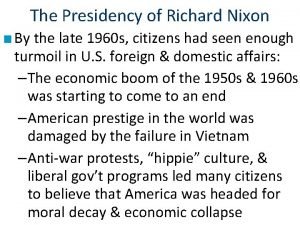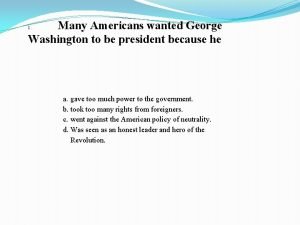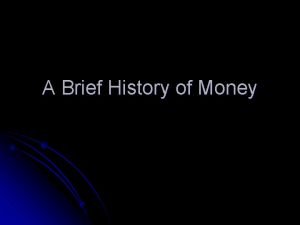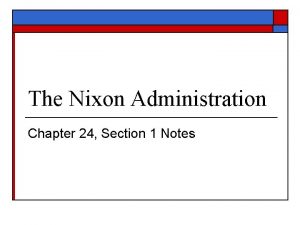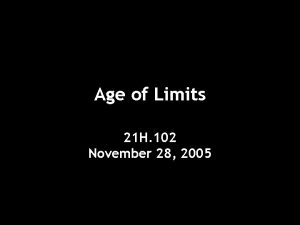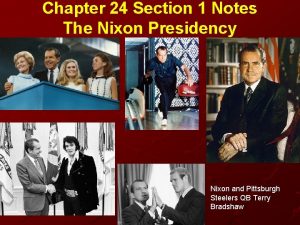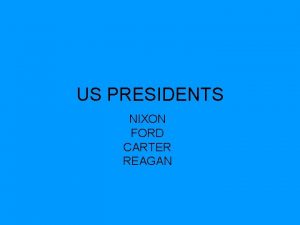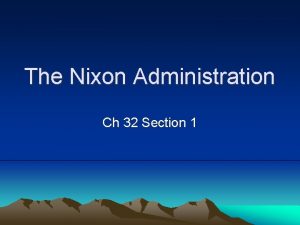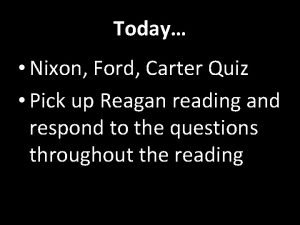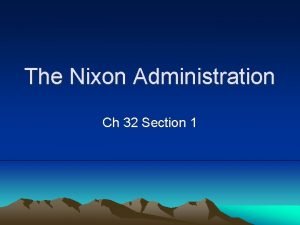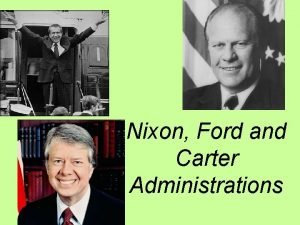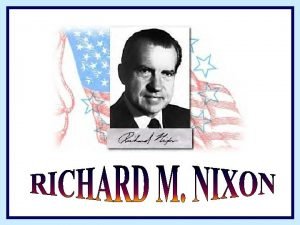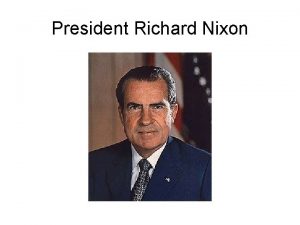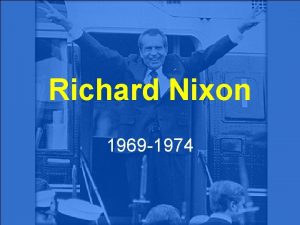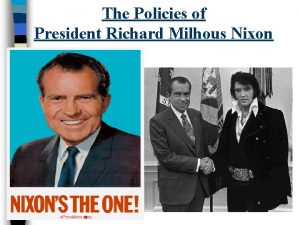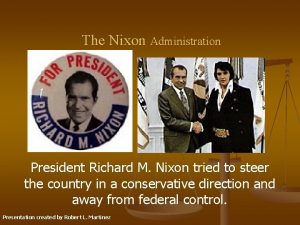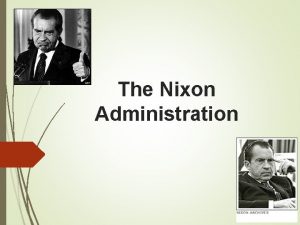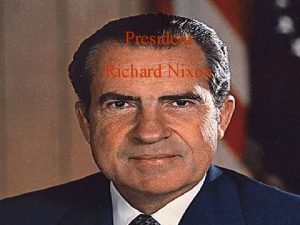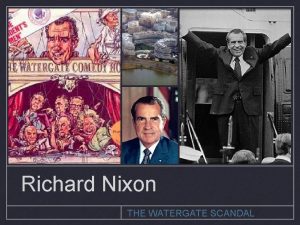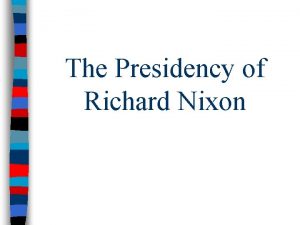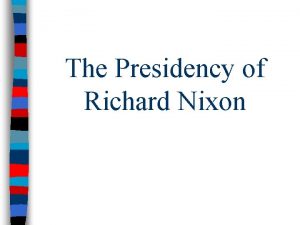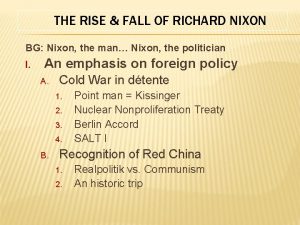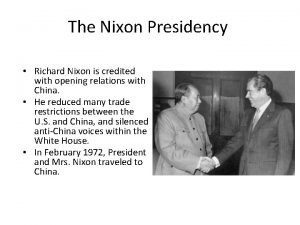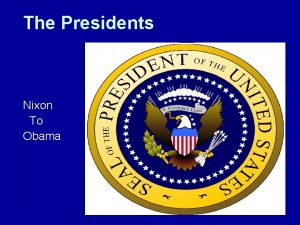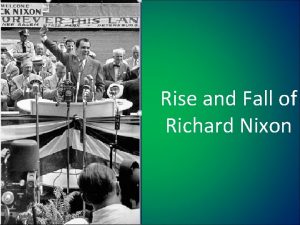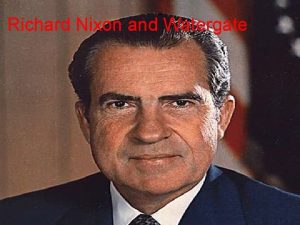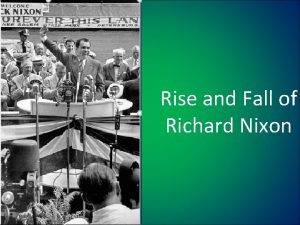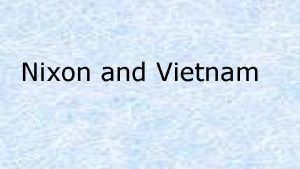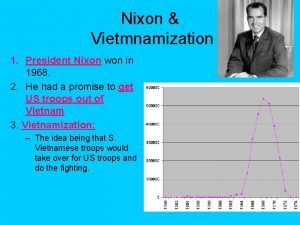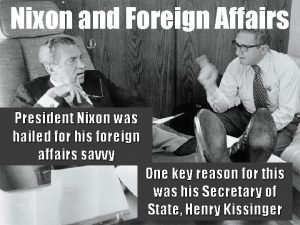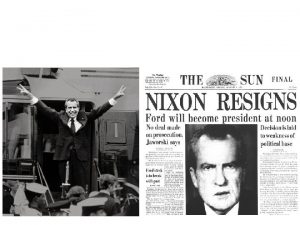From President Richard Nixon to President George W
















![Broadband Over Power Lines: Promoting Broadband Innovation “Broadband over power lines [BPL] holds promise Broadband Over Power Lines: Promoting Broadband Innovation “Broadband over power lines [BPL] holds promise](https://slidetodoc.com/presentation_image_h2/0f6fddf78a40b34b63aeac335d517adc/image-17.jpg)







- Slides: 24

From President Richard Nixon to President George W. Bush: The Rising Importance of Communications Technology and Trade in the 21 st Century WIRELESS TELECOMMUNICATIONS SYMPOSIUM 2004 Michael D. Gallagher Acting Assistant Secretary U. S. Department of Commerce National Telecommunications and Information Administration www. ntia. doc. gov May 14, 2004

Overview n About the NTIA n Promoting Economic Growth n State of Telecom Sector from President Nixon to President George W. Bush n Spectrum Policy n The President’s Broadband Agenda n New Technologies n The Importance of Trade

The National Telecommunications and Information Administration (NTIA) n n n NTIA, under the leadership of Commerce Secretary Don Evans, serves as the President's principal adviser on telecommunications and information policy matters, but is not the regulator of telecommunications, which is the job of the independent Federal Communications Commission. Our second major function is to be the manager of the nation’s airwaves, or radio spectrum, by federal government agencies, including the military. We have joint jurisdiction with the FCC over spectrum allocation and use. NTIA’s goal is to enhance the public interest by promoting quality service, competition, consumer welfare, and economic and social opportunities for all.

Spectrum Allocation Chart

Overarching Goal: Promoting Economic Growth n Thanks to the President’s policies, America is once again growing: § U. S. economy grew at 4. 2% in the first quarter of 2004; economic growth in second half of 2003 was the fastest in nearly 20 years. § Payroll employment increased by 288, 000 in April, with 867, 000 new jobs created so far this year. Over 1 million new jobs have been created since August 2003. § There has been a sharp pickup in business spending on capital equipment. § Homeownership is presently at its highest lever – 68. 6 % in the first quarter of 2004. § Advance estimates of U. S. retail and food services sales for March 2004 were $333 billion, an increase of 1. 8% from the previous month and up 8. 2% from March 2003. § The President will not be satisfied until every American who wants a job has a job.

Nixon’s Telecommunications Legacy n n President Nixon established NTIA’s precursor, the Office of Telecommunications Policy (OTP) to serve as his principal telecommunications advisor. OTP was directed to develop telecommunications policies that promote the public interest, support national security, sustain and contribute to the full development of the economy and world trade, and promote effective and innovative use of telecommunications technology, resources, and services. Nixon campaigning in Philadelphia, Pennsylvania, July 1968 (Source: The Ollie Atkins Photograph Collection)

Changes in Telecommunications from the Nixon Era to Today Cellular Subscribers 0 163, 500, 000 Telephone Subscribers 100, 000 180, 000 Satellite TV Subscribers 0 20, 000 Cable Subscribers 900, 000 73, 000

Public and Private Sector Technologies Drive Increased Demand for Spectrum n Communication • Cell Phones • Personal Digital Assistants • 3 G n Entertainment • Satellite Television • Radio n Security/Public Safety • Law Enforcement Radio and Communication Services • Military Applications • Radar • E 911 • Weather Forecasting

President’s Spectrum Initiative n n n On May 29, 2003 President Bush signed an Executive Memorandum announcing the Administration’s commitment to develop and implement a comprehensive United States Spectrum Policy for the 21 st Century. The President’s Memorandum also defines two courses of action: first, the establishment of a Federal Government Spectrum Task Force; and second, to conduct public outreach to a broad range of stakeholders. This month the Task Force met with Secretary Evans to brief him on the progress of the Task Force’s report for the President.

Spectrum Relocation Fund n n n The spectrum relocation fund would substantially speed and facilitate the relocation of federal government spectrum users to new frequencies to permit the introduction of new commercial services for consumers. Under current law, the winners of spectrum auctions are required to reimburse a federal entity for the costs incurred in the process of relocating the agencies’ spectrum operations to a different spectrum band. Instead of requiring auction winners to pay twice (once at the auction and then again after negotiating uncertain relocation costs), the proposed fund would allow relocating government users to recoup their costs out of auction proceeds.

Universal, Affordable Access to Broadband by 2007 Goal “This country needs a national goal for broadband technology. . . universal, affordable access for broadband technology by 2007. ” – President George W. Bush, Albuquerque, NM, March 26, 2004 Government’s Role "The role of government is not to create wealth; the role of our government is to create an environment in which the entrepreneur can flourish, in which minds can expand, in which technologies can reach new frontiers. " -- President George W. Bush, Technology Agenda, November, 2002. “If you want something to be used more, you don’t tax it. ”– President George W. Bush, Waco, TX August 3, 2002

Creating Economic Conditions For Broadband Deployment n n Tax relief has given businesses powerful incentives to invest in broadband technology. Accelerated depreciation for capital-intensive equipment. Extension of the Internet tax moratorium; support making the moratorium permanent. Extension of the research and experimentation tax credit; support making it permanent.

Rate of Broadband’s Diffusion is Strong United States: Diffusion of consumer goods and communications services (5 % onwards) Source: OECD

But, it Needs to Be Stronger… December 2003 Source: OECD

Broadband Penetration (G 7 Countries) 1997 -2003 Source: OECD

Expanding Competition — Wireless Broadband New Technologies The Administration has made more radio spectrum available for wireless broadband technologies: n Advanced Wireless Services (“ 3 G”) • NTIA directed 90 new MHz of spectrum to accommodate 3 G services • Articulated a plan for delivering the spectrum on terms and timing that made economic sense n Ultra-wideband • NTIA tested analyzed UWB effects • Result - UWB service that allows devices to operate in over 7 GHz of spectrum at power levels so low that it effectively underlays some of the most congested frequencies n 5 GHz Spectrum • Additional 255 MHz of spectrum was made available for shared unlicensed use • Resolved a complex management issue that posed a potential barrier to the deployment of devices using 802. 11(a) Wi. Fi technology n 70/80/90 GHz • NTIA has moved to establish a web-based mechanism to facilitate the coordination of federal and non-federal operations in these frequency ranges • This new system will allow non-federal users to determine whether they have any potential frequency conflict with federal users in real-time
![Broadband Over Power Lines Promoting Broadband Innovation Broadband over power lines BPL holds promise Broadband Over Power Lines: Promoting Broadband Innovation “Broadband over power lines [BPL] holds promise](https://slidetodoc.com/presentation_image_h2/0f6fddf78a40b34b63aeac335d517adc/image-17.jpg)
Broadband Over Power Lines: Promoting Broadband Innovation “Broadband over power lines [BPL] holds promise to be the ‘Third Wire’ into American homes – a competitive, facilities-based, cost-effective new way to deliver highspeed Internet services to American citizens. ” - NTIA Acting Assistant Secretary Michael Gallagher n n n Principal concern is the risk that BPL systems might interfere with federal government radio communications or other state and private radio operators. FCC began BPL rulemaking on February 12, 2004. On April 27, 2004, NTIA published a report of Phase 1 research, measurement and analysis findings. Now NTIA is filing comments on the FCC’s proposed rules …includes key analysis findings from Phase 2 study NTIA’s complete Phase 2 study report is targeted for release later this year. Home. Plug Modem can turn an electrical outlet into an Internet connection.

RFID and Wireless Sensors n n n RFID and other wireless sensors are at early stages of development and have limitless potential for business and home use. Some current uses: tracking supplies and inventory, tracking baggage on airlines, monitoring livestock. Department of Defense and Wal-Mart Stores Inc. announced requirement for suppliers to use RFID tags by 2005. Wal-Mart projects cost savings of $8. 4 billion annually. Others using RFID include Procter & Gamble, Michelin, and Target. RFID is anticipated to increase sales by 3% from improved in-store stocks, reduce instore labor expenses up to 65%, and reduce annual store and warehouse expenses by 7. 5% (Precursor Analysis). Policy issues discussed at Department of Commerce’s April 2004 Forum Need for different types of spectrum • Need for harmonization of standards globally • Privacy concerns about information stored through RFID. §

The Importance of Trade n n As Nixon saw doors to the East, we too see opportunities in this part of the world. From 1949 until 1972, the United States did not trade with China, because of an embargo. Trade relations resumed in 1972, with total trade volume of US$ 95 million (US exports US$ 63 million, US imports of US$ 32 million). During 2003, total merchandise trade between the United States and China reached US$ 180 billion, with total Chinese exports to the United States of US$ 152. 3 billion, and total exports from the US to China of US$ 28. 4 billion.

America’s Trade with China n n Established in 1983, the U. S. -China Joint Commission on Commerce and Trade (JCCT) is a government-to-government consultative mechanism that provides a forum to resolve trade concerns and promote bilateral commercial opportunities. This year’s JCCT is chaired by Commerce Secretary Don Evans, U. S. Trade Representative Robert Zoellick and Chinese Vice Premier Wu Yi. In December 2003, President Bush and Premier Wen agreed that significantly increasing U. S. exports to China would be a priority of both governments. Currently there almost 13, 000 U. S. small and medium-sized businesses that export to China is the seventh largest market for U. S. merchandise exports. This year should see an increase in opportunities for U. S. small and medium-sized businesses (SMEs), as Chinese tariffs continue to decrease due to their WTO commitments and additional nontariff barriers are eliminated.

China Today n n n China expects 400 million mobile subscribers by 2005 China - ICT growth has generated 6% of Gross Domestic Product (GDP) growth (1/04) China is the second-largest Wi-Fi market in the world Nixon meets with Chairman Mao Tse. Tung during historic trip to China, February 1972 (Source: The Ollie Atkins Photograph Collection)

China WAPI Standards n China published two mandatory national WLAN standards effective 12/1/03 § Require encryption technique - WLAN authentication and privacy infrastructure (WAPI) n China no longer requiring all WLAN products sold in China be developed with 24 designated Chinese firms § Keeps commercial success of U. S. companies in their own hands § Potentially protects IPR of U. S. industry n Easing of WLAN regulations could increase importation of all Wi-Fi enabled devices into China § China’s WLAN market is nascent - but growth rates are significant § Revenues from Wi-Fi equipment sales are estimated at more than $500 million annually by 2007 (Source, IDC) n As a result of our efforts, including a letter signed by Secretaries Evans, Powell, USTR Zoellick and a high level U. S. -China Joint Commission on Commerce and Trade, China agreed to indefinitely shelve the regulations aimed at establishing a China-only semiconductor standard.

Trade with Russia n In the Nixon years, exports of grain dominated our trade with the Soviet Union and were so important to the United States that we concluded an agreement with the Soviet that obligated them to buy a certain volume of grain each year. At that time, the Soviet Union outlawed investment from abroad. n Today Russia actively seeks to attract foreign investment. Russian companies, like Russia's number two cellular provider Vimpelcom, are listed on the New York Stock Exchange. The United States is the largest foreign direct investor in Russia, although the total amount of investment - about $6 billion - remains modest. § Investment opportunities presently exist in energy, telecom and information technology, aviation, consumer products, and machinery and equipment industries. Many U. S. companies continue to invest. Exxon-Mobil has invested $1. 4 billion on Sakhalin Island aerospace giant Boeing reports it has invested $1. 3 billion so far.

India: An Opportunity for Investment n n n Long-standing history and partnership SUPERCOMM India 2004: Region’s number one trade show provides opportunities for U. S. business and job growth Strong growth in the mobile sector High Technology Cooperation Group Recent tariff reductions could help facilitate greater investment opportunities: • Eliminated the 16 percent excise duties on microprocessors and on hard, floppy and CD-ROM drives • Removed special duties on computers - cut excise duties from 16 to 8 percent and dropped peak customs duties from 15 percent to 10 percent • Cut customs duties on raw materials used to make electronic components and goods • Exempted the basic customs duties on infrastructure equipment for wireline, wireless and VSAT equipment
 Chapter 19 the vietnam war
Chapter 19 the vietnam war Tricky dick
Tricky dick Richard nixon
Richard nixon Ducks unlimited president
Ducks unlimited president Richard iii pursuit of power
Richard iii pursuit of power Americans wanted george washington to be president because
Americans wanted george washington to be president because Richard t de george
Richard t de george George washington vs king george iii venn diagram
George washington vs king george iii venn diagram George washington and john adams venn diagram
George washington and john adams venn diagram Nixon tally stick download
Nixon tally stick download Chapter 24 section 1 the nixon administration
Chapter 24 section 1 the nixon administration Nixon leaving white house
Nixon leaving white house Chapter 24 section 1 the nixon administration
Chapter 24 section 1 the nixon administration Vanderbilt university isfaa
Vanderbilt university isfaa Nixon ford carter reagan
Nixon ford carter reagan Precox ascites
Precox ascites Chapter 32 section 1 the nixon administration
Chapter 32 section 1 the nixon administration David milder
David milder Nixon peabody boston
Nixon peabody boston Nixon carter gay
Nixon carter gay Vicki nixon
Vicki nixon Chapter 32 section 1 the nixon administration
Chapter 32 section 1 the nixon administration Regents of university of california v bakke
Regents of university of california v bakke Jerry nixon microsoft
Jerry nixon microsoft Nixon quaker religion
Nixon quaker religion


